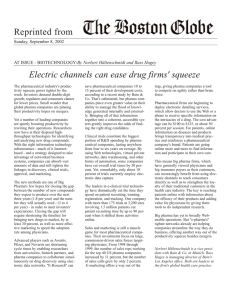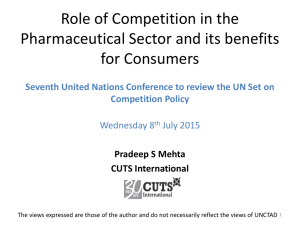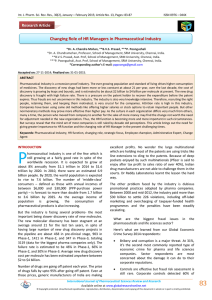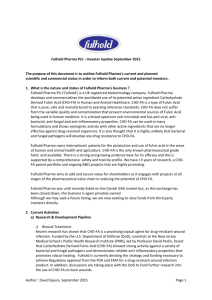Document 13310400
advertisement
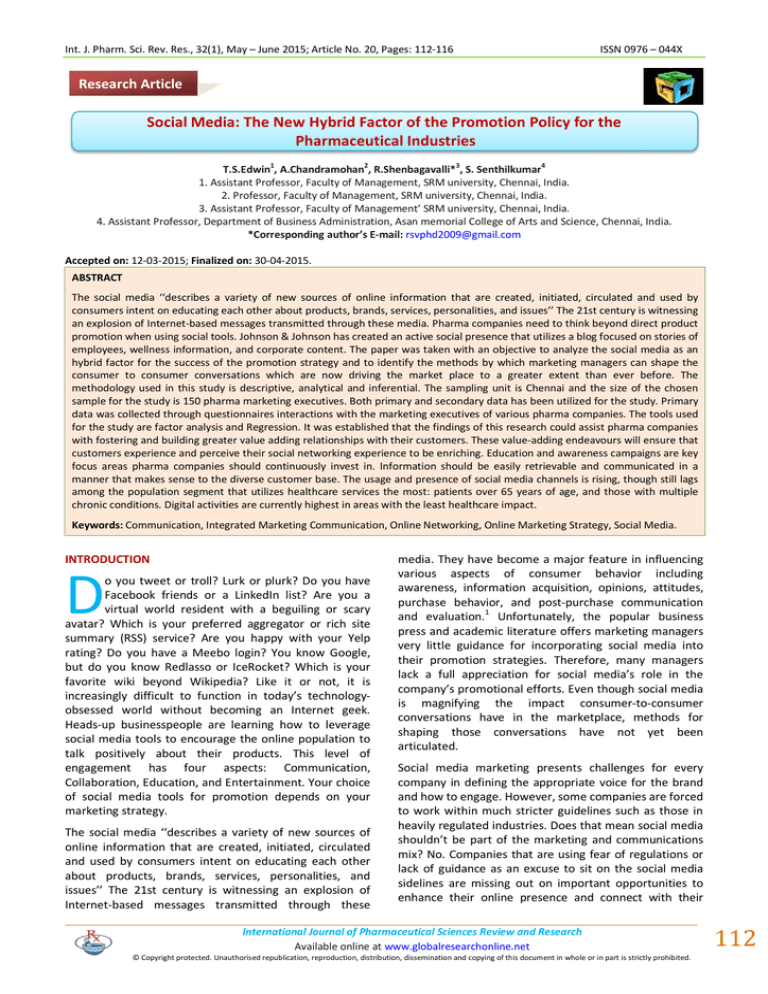
Int. J. Pharm. Sci. Rev. Res., 32(1), May – June 2015; Article No. 20, Pages: 112-116 ISSN 0976 – 044X Research Article Social Media: The New Hybrid Factor of the Promotion Policy for the Pharmaceutical Industries 1 2 3 4 T.S.Edwin , A.Chandramohan , R.Shenbagavalli* , S. Senthilkumar 1. Assistant Professor, Faculty of Management, SRM university, Chennai, India. 2. Professor, Faculty of Management, SRM university, Chennai, India. 3. Assistant Professor, Faculty of Management’ SRM university, Chennai, India. 4. Assistant Professor, Department of Business Administration, Asan memorial College of Arts and Science, Chennai, India. *Corresponding author’s E-mail: rsvphd2009@gmail.com Accepted on: 12-03-2015; Finalized on: 30-04-2015. ABSTRACT The social media ‘‘describes a variety of new sources of online information that are created, initiated, circulated and used by consumers intent on educating each other about products, brands, services, personalities, and issues’’ The 21st century is witnessing an explosion of Internet-based messages transmitted through these media. Pharma companies need to think beyond direct product promotion when using social tools. Johnson & Johnson has created an active social presence that utilizes a blog focused on stories of employees, wellness information, and corporate content. The paper was taken with an objective to analyze the social media as an hybrid factor for the success of the promotion strategy and to identify the methods by which marketing managers can shape the consumer to consumer conversations which are now driving the market place to a greater extent than ever before. The methodology used in this study is descriptive, analytical and inferential. The sampling unit is Chennai and the size of the chosen sample for the study is 150 pharma marketing executives. Both primary and secondary data has been utilized for the study. Primary data was collected through questionnaires interactions with the marketing executives of various pharma companies. The tools used for the study are factor analysis and Regression. It was established that the findings of this research could assist pharma companies with fostering and building greater value adding relationships with their customers. These value-adding endeavours will ensure that customers experience and perceive their social networking experience to be enriching. Education and awareness campaigns are key focus areas pharma companies should continuously invest in. Information should be easily retrievable and communicated in a manner that makes sense to the diverse customer base. The usage and presence of social media channels is rising, though still lags among the population segment that utilizes healthcare services the most: patients over 65 years of age, and those with multiple chronic conditions. Digital activities are currently highest in areas with the least healthcare impact. Keywords: Communication, Integrated Marketing Communication, Online Networking, Online Marketing Strategy, Social Media. INTRODUCTION D o you tweet or troll? Lurk or plurk? Do you have Facebook friends or a LinkedIn list? Are you a virtual world resident with a beguiling or scary avatar? Which is your preferred aggregator or rich site summary (RSS) service? Are you happy with your Yelp rating? Do you have a Meebo login? You know Google, but do you know Redlasso or IceRocket? Which is your favorite wiki beyond Wikipedia? Like it or not, it is increasingly difficult to function in today’s technologyobsessed world without becoming an Internet geek. Heads-up businesspeople are learning how to leverage social media tools to encourage the online population to talk positively about their products. This level of engagement has four aspects: Communication, Collaboration, Education, and Entertainment. Your choice of social media tools for promotion depends on your marketing strategy. The social media ‘‘describes a variety of new sources of online information that are created, initiated, circulated and used by consumers intent on educating each other about products, brands, services, personalities, and issues’’ The 21st century is witnessing an explosion of Internet-based messages transmitted through these media. They have become a major feature in influencing various aspects of consumer behavior including awareness, information acquisition, opinions, attitudes, purchase behavior, and post-purchase communication 1 and evaluation. Unfortunately, the popular business press and academic literature offers marketing managers very little guidance for incorporating social media into their promotion strategies. Therefore, many managers lack a full appreciation for social media’s role in the company’s promotional efforts. Even though social media is magnifying the impact consumer-to-consumer conversations have in the marketplace, methods for shaping those conversations have not yet been articulated. Social media marketing presents challenges for every company in defining the appropriate voice for the brand and how to engage. However, some companies are forced to work within much stricter guidelines such as those in heavily regulated industries. Does that mean social media shouldn’t be part of the marketing and communications mix? No. Companies that are using fear of regulations or lack of guidance as an excuse to sit on the social media sidelines are missing out on important opportunities to enhance their online presence and connect with their International Journal of Pharmaceutical Sciences Review and Research Available online at www.globalresearchonline.net © Copyright protected. Unauthorised republication, reproduction, distribution, dissemination and copying of this document in whole or in part is strictly prohibited. 112 Int. J. Pharm. Sci. Rev. Res., 32(1), May – June 2015; Article No. 20, Pages: 112-116 customers. Fear should never be the driving factor for a business. Social media and Pharma companies Pharma marketing is extremely competitive and lacking in clear social media boundaries based on current regulatory guidance. Yet some healthcare and pharma companies are doing good work in the space, finding ways to connect physicians via secure social networks to improve information sharing for example. In absence of definitive social media policy from the regulatory bodies, pharmaceutical companies need to work closely with their legal team along with marketing professionals (whether internal or external) with a strong understanding of social media engagement to ensure that the spirit of the laws are being followed despite a gray area until formal social media guidance is released. Pharma companies need to think beyond direct product promotion when using social tools. Johnson & Johnson has created an active social presence that utilizes a blog focused on stories of employees, wellness information, and corporate content. The blog contains robust content and is supplemented with YouTube and Face book pages. J&J also connects with community members via communications staffer Marc Monseau who tweets on behalf of the brand in a more personal voice. The impact of social media on drug advertising: Why pharmaceutical companies should engage with social media? To create the system of: (1) Risk communication (2) Profiling (3) Education (4) Sentiment.2 Perception about the use of social media among pharmaceutical employees 1. Indian regulatory authority should pass a law to allow pharmaceutical companies for usage of social media for Product marketing 2. Social media can help to create a specific product positioning for a specific target market 3. Social media may increase the chance of selfmedication among patients 4. Social media can play an important role in making good relationship with health care providers by directly interacting with them 5. Social media can cause a direct and unethical targeting of particular competitors 6. Social media helps in effective segmentation and targeting of customers by inviting product specific patients and health care providers on social media 7. Unlimited coverage, accessibility and convenience of social media usage make it a big tool for pharmaceutical marketers 8. Presence on social media can cause a maximum exposure in front of huge population of patients and health care providers which is very good for product promotions ISSN 0976 – 044X 9. Social media is helpful in getting competitive advantage by highlighting risk information of competitors 10. Success stories of any patients by using any specific medicine which share on social media can positively affect the sales volume of that specific product 11. Better understanding among the patients about the nature, prognosis and management of their current illness through social media can create a positive impact towards company 12. Social media serve as a path for keeping the doctors on their toes to constantly update themselves with recent advances offered by pharmaceutical companies 13. Patient can suggest doctors to prescribe that specific medicine which they have come to know through social media page of company 14. Social media is only suitable for the marketing of over the counter (OTC) medicines 15. Social media is a perfect tool for the marketing of any type of medicine used in any disease 16. Pharmaceutical marketing on social media specifically increase the usage of medications used in young ages because social media is heavily using by young population 17. Social media is a suitable medium for marketing research in order to develop and launch any product because from social media we can get customer’s insights both doctors and patients for new product development 18. Pharmaceutical companies should embrace social media marketing as regular marketing activity in order to increase market share and maximize the exposure of company in general population Objectives of the study To analyze the social media as an hybrid factor for the success of the promotion strategy To identify the methods by which marketing managers can shape the consumer to consumer conversations which are now driving the market place to a greater extent than ever before Review of Literature (Jeremy)(2010) Manufacturers are in a better position to monitor online discussions about their products: most U.S. companies that depend on copyright and trademark recognition currently engage in brand-protection activities through aggressive surveillance and litigation. Hospitals increasingly are using social networks for promotional purposes and to gauge consumer experiences with their organizations. More than 700 of the U.S.’ 5,000 hospitals have a social media and social International Journal of Pharmaceutical Sciences Review and Research Available online at www.globalresearchonline.net © Copyright protected. Unauthorised republication, reproduction, distribution, dissemination and copying of this document in whole or in part is strictly prohibited. 113 Int. J. Pharm. Sci. Rev. Res., 32(1), May – June 2015; Article No. 20, Pages: 112-116 networking presence to enhance their ability to market services and communicate to stakeholders.3 The social network venue is rife with misinformation, which might lend itself to consumer trust issues if key health care industry groups are thought to be “manipulating” the free flow of information. Deloitte’s 2010 Survey of Health Care Consumers suggests that health insurance plans and manufacturers are the leasttrusted sources of health information, with approximately one-third of respondents indicating that they distrust information from these organizations.4 More than possibly any other industry, the pharmaceutical industry is constrained in how it communicates with its customers—exemplified by the advertising real estate that pharmaceutical companies must allocate to side effects and possible adverse events (AEs) associated with their products. It is completely understandable that the constraints around pharmaceutical companies’ ability to speak to their customers would affect how they listen to their customers. We believe, however, that the two do not need to go hand in hand; that there are ample opportunities for pharmaceutical manufacturers to listen to their customers, and to better serve the public and gain competitive advantage by doing so.5 METHODOLOGY The methodology used in this study is descriptive, analytical and inferential. The sampling unit is Chennai and the size of the chosen sample for the study is 150 pharma marketing executives. Both primary and secondary data has been utilized for the study. Primary data was collected through questionnaires interactions with the marketing executives of various pharma companies. The instrument utilized for data collection is questionnaire. The secondary data has been collected through internet, books, and journals. The tools used for the study are factor analysis and Regression. ISSN 0976 – 044X RESULTS AND DISCUSSIONS Categorization through all the social media options can be confusing for a business. They must approach the decision by using a rating scale that ranks social media options from zero to four to denote degree from “not valuable” to “extremely valuable.” Or, develop a approach by using a “SWOT analysis” to assess “strengths and weaknesses,” as well as “opportunities and threats.” To agree on strengths and weakness, we can raise what your company does best – and worst – and how those traits will transform via social media tools. For opportunities and threats, we ask what external issue might work against your firm online and what elements might work for it. This assessment will position you in the right direction. As the companies plan, develop and implement their strategy, it’s advised to follow three basic rules for social media marketing: 1. The goal is to enable positive online discussion about the products. 2. The Internet is about influence, not control. We cannot control how people react to the firm and its social media activities – but we can influence their responses. 3. All online business relationships fully depend on this form of influence. Presently, in the global scenario the platform exposed by the pharma industries to communicate their product and make them reach successfully to the the targeted population and also to develop their customer database of the population regualrly using their products and also the population which can be influenced to use their products. The chart below gives an idea of the communication strategy presently used by the pharma companies. Its evident that the prime strategy designed to advertise the pharma products is through the advertising and direct selling and later it comes to social media. Which we project to be changed and more thrust to be given to online branding and usage of technology for promoting pharma products. International Journal of Pharmaceutical Sciences Review and Research Available online at www.globalresearchonline.net © Copyright protected. Unauthorised republication, reproduction, distribution, dissemination and copying of this document in whole or in part is strictly prohibited. 114 Int. J. Pharm. Sci. Rev. Res., 32(1), May – June 2015; Article No. 20, Pages: 112-116 Factor analysis: Measure the conversion rate: how many have visited your site and got converted to use your products (0.66). Measure the success rate of your brand via social media(0.66). Measure the number of hits seen for your site (0.64). Companies prefer to take up the campaigns in the colleges (0.62). Companies conduct various context and competitions online through their sites and create awareness (0.60). Get help from the pharma students by way of internship to promote your products in social networking sites through their groups (0.52). Health details enhance people and it brings enthusiasm to know details about the disease (0.52). Table 1: KMO and Bartlett's Test results showing sampling adequacy Kaiser-Meyer-Olkin Measure of Sampling Adequacy. .941 Bartlett's Test of Sphericity Approx. Chi-Square Df Sig. 59085.009 2211 .000 KMO test is significant as the p value is less than 0.05 and kmo measure of sampling is greater than 0.8 indicates that the sample is adequate. Since the cronbachs alpha value is greater than 0.98 the reliability is established In order to study the effectiveness of social media marketing in pharma companies, the factor analysis method was employed. There are 5 independent groups that were extracted, which account for a total of 75.55% of the variations on the 25 variables showing the effectiveness and success of social media for pharma products. The 5 factors (each) contribute 18.01%, 12.72%, 12.24%, 10.81%, and 8.10%, to the variations respectively and cronbachs alpha value is found. It is inferred that out of the 25 items of effectiveness of social media, fifteen variables have high and relatively tightly grouped factor loadings on Factor 1. This factor consists of: The majority of the population in the age group of 18 – 30 is using the social media sites during 1 to 4 p.m, considered to be the best time for posting ads and important information images (0.74). The traffic is very high during the 5-6 p.m by the people falling under the age group of 30-45, an ideal time for providing doctors’ information and health advices (0.73). Pharma companies adequately developed uses of images competencies (0.71). Most of the companies prefer to use images as it takes higher click through rate (0.71). LinkedIn used mostly to create network among like – minded business people (0.71). The marketing executives preferring slideshare to reach new customers (0.70). Social media marketing and updating information is an ongoing process (0.69). Social media helped to remain updated with latest practices and new drugs by different pharma companies (0.68). of ISSN 0976 – 044X Regression Analysis The Multiple Regression was fitted to identify the methods influencing the best communication platform to help the marketing managers to shape the consumer to consumer conversation to success the products online. YSMPH=0.157+1.842*time+1.429*awarofpe+1.349*nohit -1.389*sucofimag+1.545*preslish+1.396* bransucc (20.371) (18.456) (15.685) (22.140) (22.282) (16.359) +1.319*olibl+1.619*sotide+ 1.671*nprocomm-0.991* ratebredo+1.524* veoft+1.130* int+1.406* proj (16.449) (17.505) (20.156) (13.433) (15.156) (11.522) (16.178) -1.177* wrshcamp (16.942) R2= 0.993, F= 2324.529 Interpretation: regressions were fitted to identify the determinants of successful methods to achieve the best result on consumer to consumer relationship and conversation. The regression was fitted with effective consumer to consumer conversation method to success the pharma product as the dependent variable and time to place your promotion advertisement in facebook, in tweeter, in linkedIn, small networks, slideshares, ppts, age of targeted population, branding success, images using tools, own images, internships, projects, campaigns, competitions were considered as independent variable. The equation fitted indicated an R2 value indicated that more than 99% of variation in social media methods is explained by the independent factors included for the analysis. The F value (2324.529) implied that R2 (0.993) is statistically significant and so the equation is fit for interpretation. From the equation we notice that the promotional advertisements and health information’s posted in facebook during 1 to 4 P.M increases the usage International Journal of Pharmaceutical Sciences Review and Research Available online at www.globalresearchonline.net © Copyright protected. Unauthorised republication, reproduction, distribution, dissemination and copying of this document in whole or in part is strictly prohibited. 115 Int. J. Pharm. Sci. Rev. Res., 32(1), May – June 2015; Article No. 20, Pages: 112-116 and hit of the user by 1.842units, issues of health and doctor’s details hikes the usage and hits of consumers and sharing of such information with other friends by the consumer itself by 1.429units, the details of health issues and the importance and side effects of drugs taken without the doctor’s advice are presented in a crisp manner using the slideshare and other details in the form of videos increases the confidence and seeking information approach of the consumers by 1.349 units which directly influences the trustworthy of usage of information casted on the pharma websites. When the population aged in the range of 35-45 years the hits and usage is minimum (-1.389units), when the users search for the branded drugs and particular about the company manufacturing such drugs again the success rate is very high (1.545units) which means the users are not exposed to any risk. on healthcare is yet to be fully understood. Examples of metrics that reflect the scope and scale of the new digital landscape include: Use of social networking sites has grown from 8% of all adults online in 2005, to 67% in late 2012 and up to 72% of adults online in May 2013. When making clinical decisions, physicians spend twice as much time using online resources as compared to print. REFERENCES 1. Murray Aitken Executive Director IMS Institute for Healthcare Informatics; Engaging patients through social media; Jan 2014; Report by IMS Institute for healthcare Informatics. 2. Hospital Social Network Data & Charts, Bennett Ed. May 22, 2010, http://ebennett.org/hsnl/data 3. Jeremy A. Greene, M.D., Ph.D., and Aaron S. Kesselheim, M.D., J.D., M.P.H.N Engl J Med 2010; Pharmaceutical Marketing and the New Social Media. 363, 2010, 20872089. DOI: 10.1056/NEJMp1004986 4. 2010 Survey of Health Care Consumers, Deloitte Center for Health Solutions. 5. How Pharmaceutical Manufacturers Can Leverage Consumer-Generated Media. Melissa Davies Research Director, Healthcare Nielsen Online August 2008. www.nielsen-online.com. 6. Greene JA, Herzberg D. Hidden in plain sight: marketing prescription drugs to consumers in the twentieth century. Am J Public Health, 100, 2010, 793-803. 7. W. Glynn Mangold, David J. Faulds. Social media: The new hybrid element of the promotion mix. Business Horizons, 52, 2009, 357—365. CONCLUSION The usage and presence of social media channels is rising, though still lags among the population segment that utilizes healthcare services the most: patients over 65 years of age, and those with multiple chronic conditions. Digital activities are currently highest in areas with the least healthcare impact. Social media channels are diverse, provide different user experiences, and are subject to rapid shifts in use. The role of social networks in healthcare is critical throughout a patient’s journey, and demand by patients for support is high, with social media expanding on the habit of discussing healthcare with family and friends. The rising volume of digital healthcare activity is well recognized, even if the impact ISSN 0976 – 044X Source of Support: Nil, Conflict of Interest: None. International Journal of Pharmaceutical Sciences Review and Research Available online at www.globalresearchonline.net © Copyright protected. Unauthorised republication, reproduction, distribution, dissemination and copying of this document in whole or in part is strictly prohibited. 116
